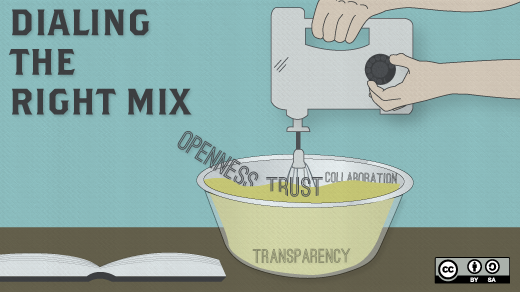This should come as no surprise: Open source principles are great guidelines for conducting successful collaboration sessions. What wasn’t as obvious to me was that the different principles are more important in different collaboration situations. Imagine the concepts of trust, openness, transparency, and release early, release often as ingredients in a mix, controlled by a row of dials. The environment determines how much you need to 'dial up' or 'dial down' each characteristic.
I recently started a graduate program where I realized the dynamics around collaboration are different than they are at work. In school groups, certain principles needed more attention—and others not so much.
In the business world, a team is often assembled based on talents and skill sets. There is a leader or leaders a team answers to who can make decisions if consensus can’t be met. Teams also work towards a common goal. Sometimes it might not feel like it, but at the very least everyone wants the company to succeed.
In a classroom, group projects are often assembled randomly or based on friendships—often without regard for ability. Leadership can be tricky, because hierarchy doesn't really exist. And finding a specific common goal can be hard when everyone is there for a different reason. I think this is especially true in graduate school.
Trust is important any time collaboration is necessary, but when members do not know each other and leadership and goals are unclear, 'dialing up' trust should be the priority. Before you dive into actual project logistics, I recommend taking a few steps back and considering the five guidelines below.
- Get to know each other first. Identify which open source characteristics need to be dialed up or down based on team dynamics.
- Openly discuss each team members' quirks, strengths, and weaknesses.
- Determine how decisions will be made. If there isn’t 100 percent consensus what will the team do? Is 75 percent good enough? Rock-paper-scissors to resolve disputes?
- Identify the ways your team will want to collaborate.
- Create ground rules around how open and flexible the idea generation process will be.
The initial goal and primary focus of a meeting like this should be to create a safe collaboration environment. You might have to compromise, but everyone should be prepared to do so. And while it won’t eliminate all of your problems, it will help set the right attitude for fruitful collaboration.
Share your collaboration successes and failures. What rules do you follow for successful collaboration? What was different in your successes versus failures?






1 Comment